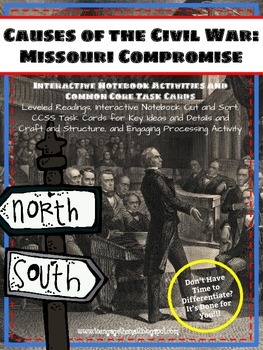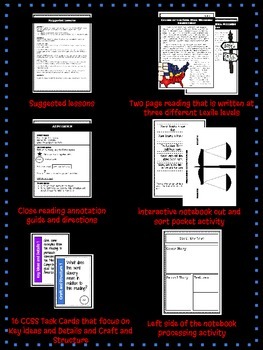Causes of the Civil War: Missouri Compromise Readings and Interactive Notebook
Engaging Them All
2.4k Followers
Grade Levels
4th - 9th, Homeschool
Resource Type
Standards
CCSSRH.6-8.1
CCSSRH.6-8.2
CCSSRH.6-8.3
CCSSRH.6-8.4
CCSSRH.6-8.5
Formats Included
- PDF
Pages
20 pages
Engaging Them All
2.4k Followers
Description
Work on close reading skills, engage students, differentiate for various learners, and learn about the Missouri Compromise all at the same time. Included in this lesson you will find:
One reading at three different reading levels:
Annotation directions
Interactive Notebook Cut and Sort with directions and answer key
16 close reading task cards that ask students to work with Common Core Standards Key Ideas and Details and Craft and Structure
Left side of the notebook processing activity
Teacher directions
************************************************************************
If you like this item you might want to check out these:
French and Indian War Differentiated Readings & Interactive Notebook Activities!
13 Colonies Interactive Notebook Mini - Unit - Differentiated
American Revolution: Continentals v. British Interactive Notebook
Leading to the American Revolution: Interactive Notebook and Flippable Activity
Articles of Confederation Leveled Readings,Task Cards, and Notebook Foldables
************************************************************************
If you would like to see how I use my items in my classroom please visit me at To Engage Them All!
Key Words: Civil War, Causes of the Civil War, Henry Clay, Missouri Compromise, north and south, interactive notebooks
Total Pages
20 pages
Answer Key
Included
Teaching Duration
2 days
Report this resource to TPT
Reported resources will be reviewed by our team. Report this resource to let us know if this resource violates TPT’s content guidelines.
Standards
to see state-specific standards (only available in the US).
CCSSRH.6-8.1
Cite specific textual evidence to support analysis of primary and secondary sources.
CCSSRH.6-8.2
Determine the central ideas or information of a primary or secondary source; provide an accurate summary of the source distinct from prior knowledge or opinions.
CCSSRH.6-8.3
Identify key steps in a text’s description of a process related to history/social studies (e.g., how a bill becomes law, how interest rates are raised or lowered).
CCSSRH.6-8.4
Determine the meaning of words and phrases as they are used in a text, including vocabulary specific to domains related to history/social studies.
CCSSRH.6-8.5
Describe how a text presents information (e.g., sequentially, comparatively, causally).



